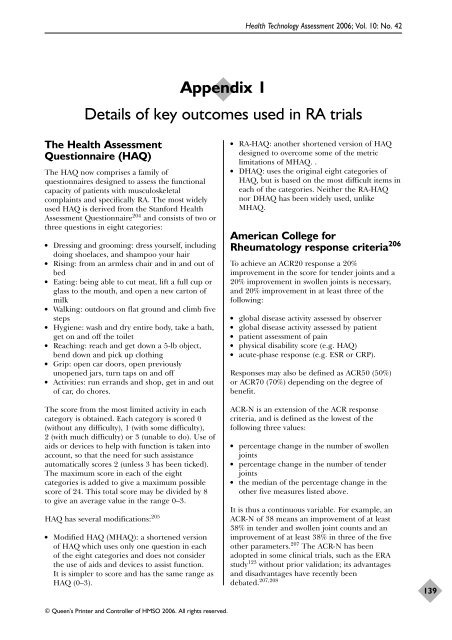A systematic review of the effectiveness of adalimumab
A systematic review of the effectiveness of adalimumab
A systematic review of the effectiveness of adalimumab
Create successful ePaper yourself
Turn your PDF publications into a flip-book with our unique Google optimized e-Paper software.
The Health Assessment<br />
Questionnaire (HAQ)<br />
The HAQ now comprises a family <strong>of</strong><br />
questionnaires designed to assess <strong>the</strong> functional<br />
capacity <strong>of</strong> patients with musculoskeletal<br />
complaints and specifically RA. The most widely<br />
used HAQ is derived from <strong>the</strong> Stanford Health<br />
Assessment Questionnaire 204 and consists <strong>of</strong> two or<br />
three questions in eight categories:<br />
● Dressing and grooming: dress yourself, including<br />
doing shoelaces, and shampoo your hair<br />
● Rising: from an armless chair and in and out <strong>of</strong><br />
bed<br />
● Eating: being able to cut meat, lift a full cup or<br />
glass to <strong>the</strong> mouth, and open a new carton <strong>of</strong><br />
milk<br />
● Walking: outdoors on flat ground and climb five<br />
steps<br />
● Hygiene: wash and dry entire body, take a bath,<br />
get on and <strong>of</strong>f <strong>the</strong> toilet<br />
● Reaching: reach and get down a 5-lb object,<br />
bend down and pick up clothing<br />
● Grip: open car doors, open previously<br />
unopened jars, turn taps on and <strong>of</strong>f<br />
● Activities: run errands and shop, get in and out<br />
<strong>of</strong> car, do chores.<br />
The score from <strong>the</strong> most limited activity in each<br />
category is obtained. Each category is scored 0<br />
(without any difficulty), 1 (with some difficulty),<br />
2 (with much difficulty) or 3 (unable to do). Use <strong>of</strong><br />
aids or devices to help with function is taken into<br />
account, so that <strong>the</strong> need for such assistance<br />
automatically scores 2 (unless 3 has been ticked).<br />
The maximum score in each <strong>of</strong> <strong>the</strong> eight<br />
categories is added to give a maximum possible<br />
score <strong>of</strong> 24. This total score may be divided by 8<br />
to give an average value in <strong>the</strong> range 0–3.<br />
HAQ has several modifications: 205<br />
● Modified HAQ (MHAQ): a shortened version<br />
<strong>of</strong> HAQ which uses only one question in each<br />
<strong>of</strong> <strong>the</strong> eight categories and does not consider<br />
<strong>the</strong> use <strong>of</strong> aids and devices to assist function.<br />
It is simpler to score and has <strong>the</strong> same range as<br />
HAQ (0–3).<br />
Appendix 1<br />
Health Technology Assessment 2006; Vol. 10: No. 42<br />
Details <strong>of</strong> key outcomes used in RA trials<br />
© Queen’s Printer and Controller <strong>of</strong> HMSO 2006. All rights reserved.<br />
● RA-HAQ: ano<strong>the</strong>r shortened version <strong>of</strong> HAQ<br />
designed to overcome some <strong>of</strong> <strong>the</strong> metric<br />
limitations <strong>of</strong> MHAQ. .<br />
● DHAQ: uses <strong>the</strong> original eight categories <strong>of</strong><br />
HAQ, but is based on <strong>the</strong> most difficult items in<br />
each <strong>of</strong> <strong>the</strong> categories. Nei<strong>the</strong>r <strong>the</strong> RA-HAQ<br />
nor DHAQ has been widely used, unlike<br />
MHAQ.<br />
American College for<br />
Rheumatology response criteria 206<br />
To achieve an ACR20 response a 20%<br />
improvement in <strong>the</strong> score for tender joints and a<br />
20% improvement in swollen joints is necessary,<br />
and 20% improvement in at least three <strong>of</strong> <strong>the</strong><br />
following:<br />
● global disease activity assessed by observer<br />
● global disease activity assessed by patient<br />
● patient assessment <strong>of</strong> pain<br />
● physical disability score (e.g. HAQ)<br />
● acute-phase response (e.g. ESR or CRP).<br />
Responses may also be defined as ACR50 (50%)<br />
or ACR70 (70%) depending on <strong>the</strong> degree <strong>of</strong><br />
benefit.<br />
ACR-N is an extension <strong>of</strong> <strong>the</strong> ACR response<br />
criteria, and is defined as <strong>the</strong> lowest <strong>of</strong> <strong>the</strong><br />
following three values:<br />
● percentage change in <strong>the</strong> number <strong>of</strong> swollen<br />
joints<br />
● percentage change in <strong>the</strong> number <strong>of</strong> tender<br />
joints<br />
● <strong>the</strong> median <strong>of</strong> <strong>the</strong> percentage change in <strong>the</strong><br />
o<strong>the</strong>r five measures listed above.<br />
It is thus a continuous variable. For example, an<br />
ACR-N <strong>of</strong> 38 means an improvement <strong>of</strong> at least<br />
38% in tender and swollen joint counts and an<br />
improvement <strong>of</strong> at least 38% in three <strong>of</strong> <strong>the</strong> five<br />
o<strong>the</strong>r parameters. 207 The ACR-N has been<br />
adopted in some clinical trials, such as <strong>the</strong> ERA<br />
study 123 without prior validation; its advantages<br />
and disadvantages have recently been<br />
debated. 207,208<br />
139
















